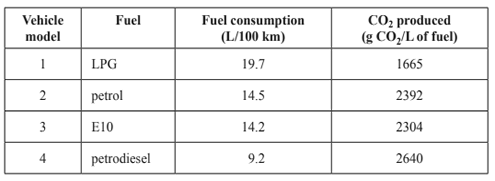1) Which one of the following is a biofuel?
A. ethanol produced from crude oil
B. ethanol produced from cellulose
C. propane produced from natural gas
D. electricity produced by hydropower
Solution

2) Four identical vehicle models, 1, 2, 3 and 4, were tested for fuel efficiency using LPG, petrol (unleaded, 91 octane), E10 (petrol with 10% ethanol added) and petrodiesel. Carbon dioxide, emissions per litre of fuel burnt were also determined. The following table summarises the results.

a) Using the information in the table above, which one of the following statements about petrodiesel is correct?
A. It has the highest energy content.
B. It has the poorest fuel efficiency.
C. It is a renewable energy source.
D. It has the lowest CO2 emissions when burnt.
Solution

b) The use of which vehicle has the smallest impact on the environment, in terms of the grams of CO2 produced per 100 km?
A. Vehicle model 1
B. Vehicle model 2
C. Vehicle model 3
D. Vehicle model 4
Solution

3) A Year 12 Chemistry assignment requires students to quantitatively and qualitatively compare fossil fuels and biofuels. Which one of the following investigations would be most appropriate for this comparison?
A. Use a bomb calorimeter to determine the heat of combustion for both fossil fuels and biofuels.
B. Interview car owners to determine what petrol price would make them consider using biofuels.
C. Produce biodiesel from vegetable oil and compare the viscosity of the biodiesel produced with that of a range of fossil fuels.
D. Find reliable information about the environmental impacts of producing fossil fuels and biofuels, and the amount of carbon dioxide produced per litre from the combustion of these fuels.
Solution

4).A vehicle that is powered by a diesel engine is able to use either petrodiesel or biodiesel as a fuel. Petrodiesel and biodiesel are not pure substances, but are a mixture of molecules. In general, petrodiesel consists of molecules that are shorter in length, on average, than those found in biodiesel. Biodiesel contains molecules that include functional groups. The table below lists some of the properties of the two fuels.
 a) Describe and explain the difference in viscosity, under the same conditions, of the two fuels and how this would affect the flow of each fuel
a) Describe and explain the difference in viscosity, under the same conditions, of the two fuels and how this would affect the flow of each fuel
Solution

b) Assume that combustion occurs in an unlimited supply of oxygen and use the data from the table on page above to calculate the number of litres of biodiesel that are required to be burnt to produce the same amount of energy as 2.5 kg of petrodiesel density (biodiesel) =
0.89 kg L–1
c) calculate the mass of carbon dioxide, that would be produced from 3.91 kg of biodiesel.
Solution

5) In some circumstances, there is a limited supply of oxygen.
Write the balanced chemical equation for the combustion reaction of the major component of biodiesel, C19H32O2, where carbon monoxide, CO, is the only product containing carbon.
Solution
